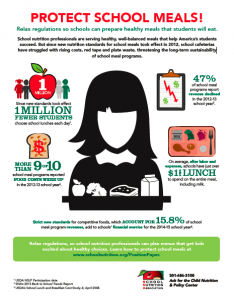School Nutrition Association: junk foods galore (but they meet USDA’s nutrition standards)
Politico ProAg’s Helena Bottemiller Evich has been reporting on the School Nutrition Association (SNA) meeting in Boston this week (and see the video conversation with her editor, Jason Huffman, about the meeting).
One of her points: from the kinds of junk-food products exhibited, you would never know that the SNA was at war with the White House over USDA’s nutrition standards for school meals (see my previous posts).
As she explains, food companies have had no problem coming up with look-alike products that meet USDA standards:
More than 400 exhibitors showed off their innovations designed to meet the Department of Agriculture’s new regulations…PepsiCo, which owns Tropicana, Quaker and Lays, has a long list of products that meet the new rules, including Reduced Fat Doritos and Cheetos, Stacy’s Pita Chips and Munchies. Windsor Foods, which specializes in food service, has come up with whole grain-rich egg rolls that the company says kids love.
General Mills displayed a modified version of Chex Mix, a whole grain Betty Crocker cookie and a Cinnamon Toast Crunch cereal bar: “Snacks so good, kids won’t know they’re nutritious,” according to the marketing flyers.
…while the changes to lunch standards may be giving many school nutrition professionals fits, the food manufacturing industry is drooling over the opportunity to gain more sales inside what has been described as the nation’s largest restaurant: The school lunch program serves 30 million kids each day and represents a $30 billion per year market for the food industry, according to the Center for Science in the Public Interest.
…SNA benefits from the food industry’s enthusiasm in school lunches. The largest chunk of the group’s revenue is generated at its annual conference, which brought in $4.7 million in 2012. The association charges $15,000 to sponsor an education session track featuring a company representative and $20,000 to put company logos on hotel key cards.
Evich quotes Michele Simon, who also attended the meeting.
Walking through that hall, it’s very hard to see where the changes are,” she said. “It’s still pretty appalling to see the types of junk food that can pass as acceptable food for school meals. It seems like there’s a disconnect between the uproar over the improved guidelines and all these vendors who seem to have no problem meeting them.”
Michele sent me a photo of one such product.

For photos of other such items, see Michele Simon’s other images on Time Magazine’s site, and Nancy Huehnergarth’s collection of what she calls “The Good, the Bad and The Ugly Food Exhibits.”
To understand what this is about, take a look at the Public Health Advocacy Institute’s report on Copycat Snacks in Schools. The “better for you” versions are sold in schools, but you can hardly tell the difference between those and the “not so good for you” commercial versions from the nearly identical packages.
How can food and beverage companies get away with this? This is the result of USDA’s setting nutrient-based, rather than food-based standards for school meals. Setting nutrient standards allows food companies to tweak the formulas to give the USDA what it requires.
Is a slightly “better for you” option necessarily a good choice? Surely, schools can do better.




